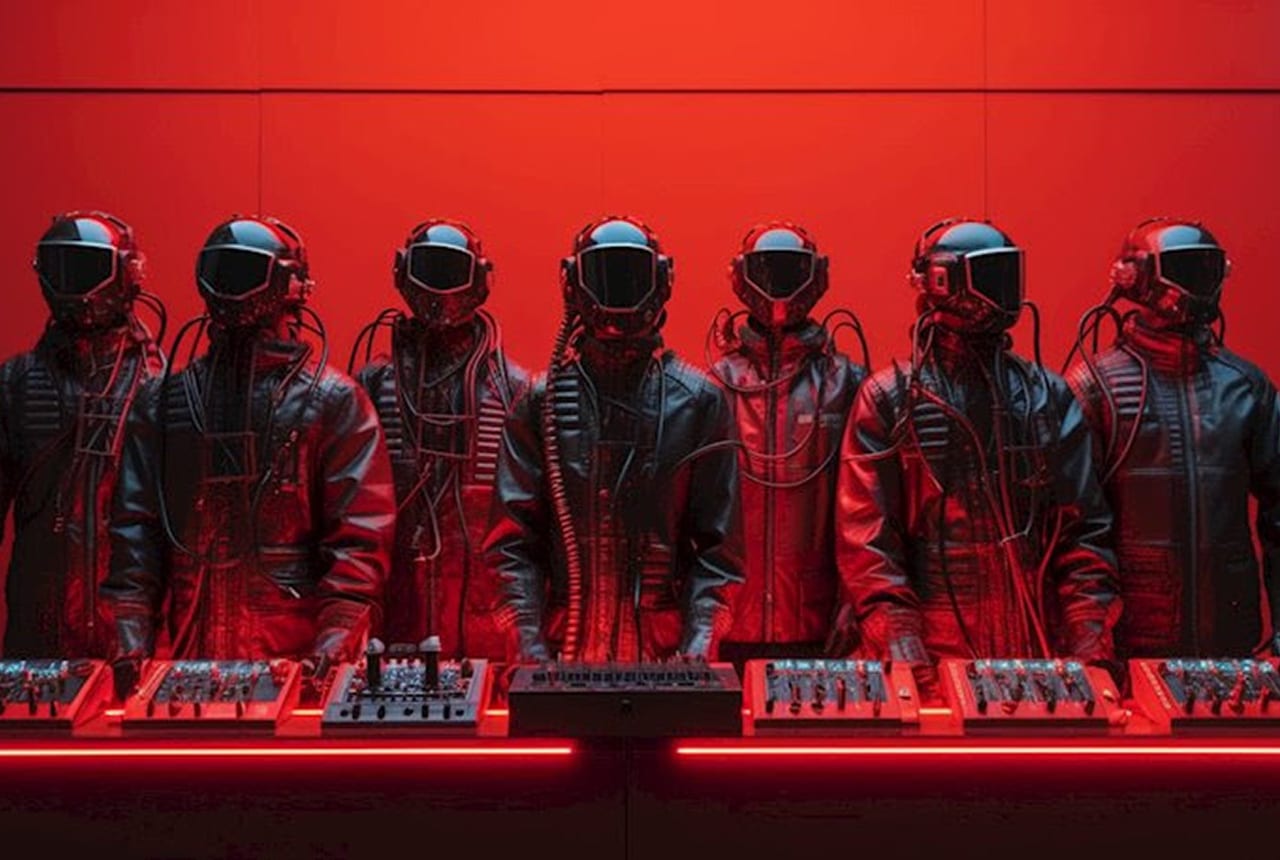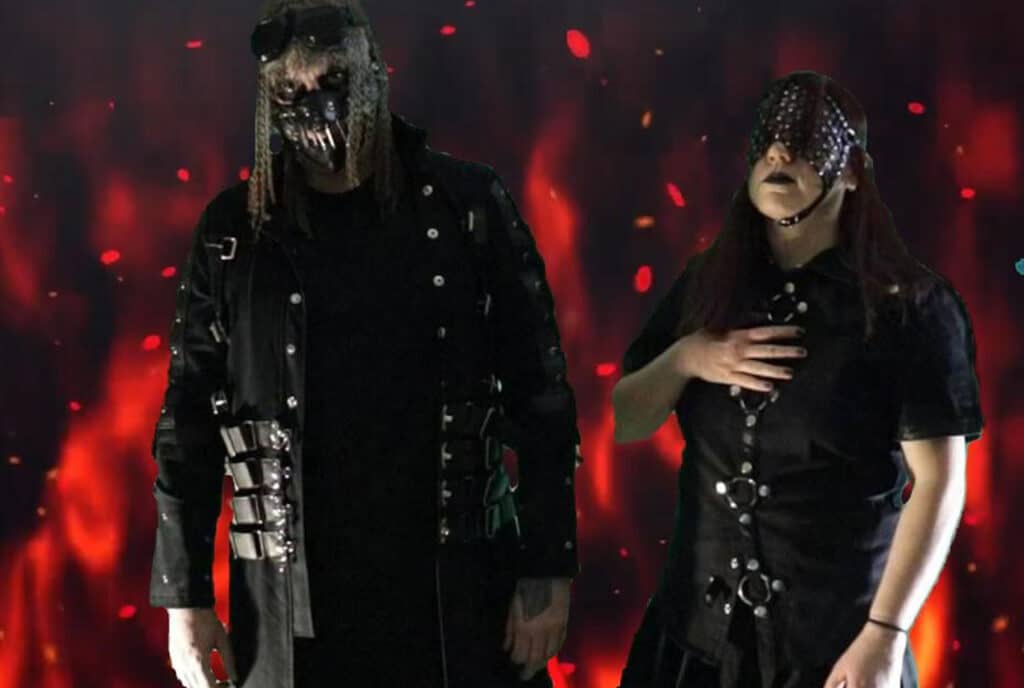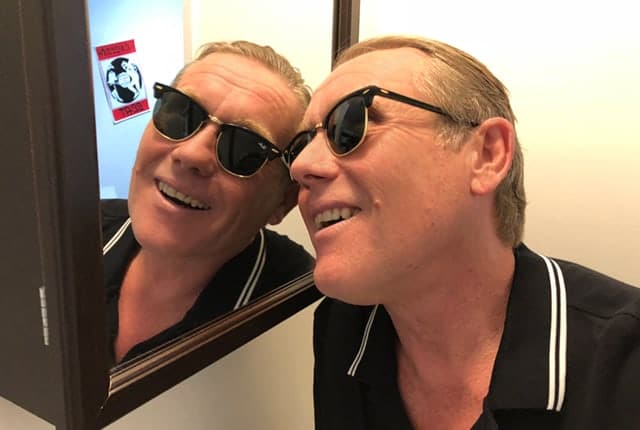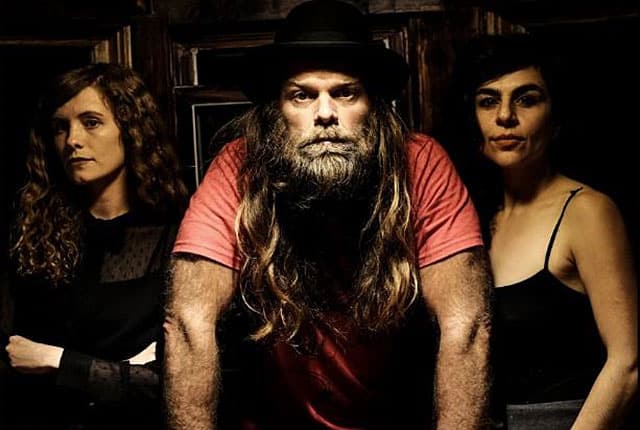With their latest album, Media Consumption Pyramid, Norwegian band Datarock explores the theme of media consumption in the digital age while recapturing the mindset of their earlier work. It wasn’t something they set out to do but another example of Covid-19 disrupting plans. The group had been rehearsing to tour in celebration of their 15th anniversary and the re-release of their debut, Datarock Datarock. When things shut down, they continued working in their rehearsal space and began writing new material with the attitude of being as electronic as possible and not worrying about impressing anyone but themselves. The result is a quirky, highly energetic, and danceable collection of songs that bring a wide variety of electronic influences into an absolutely unique sound. Over a Zoom interview, frontman, Fredrik Saroea, talked about the making of Media Consumption Pyramid.
At the time I interviewed you about your Rona Diaries: The Chamber Versions solo album, I think you mentioned the new Datarock album was complete. Could you talk about the making of Media Consumption Pyramid; the timeframe and how it came together?
Fredrik Saroea: It’s kind of similar to what we talked about with my solo album, and I think I did exactly what I’m going to do right now, back then too. So can you see that building, the white building there, and there’s a garden and there’s the basement? That’s the basement where we have a rehearsal space.
And when Covid hit, you could [only] spend time with so many people, cohort stuff. It shut down the 13th of March, 2020 and we released our debut album on, I think the 4th of March, 2005. So pretty much on the 15 year anniversary, when we were supposed to go out and to do a re-release tour and celebration tour for the debut album, everything shut down. I have two kids. Pretty much everybody in the band has day jobs and kids and families and all of that. But we’d been rehearsing so much, that original material on the first album.
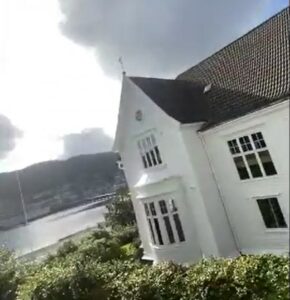
We re-released our debut album for Record Store Day 2020. And that was actually the very first time we released it on vinyl. Because Datarock was basically a MySpace band. So when we had a very active international career; that was even before streaming services like Spotify and all of that. And we sort of come from the vinyl indie world, which was very costly printing seven inches and stuff like that. So anyway, we never released the debut album on vinyl. And then just as we were releasing it for Record Store Day and the 15-year anniversary and all of this, by the way, [it was a] limited edition, orange-red, translucent vinyl, 180 grams, then everything shut down. But then we had come into this habit of going to the rehearsal space and rehearsing just kind of for the fun of it to remember how to play all those original songs. We were like, wait a minute, what we did back then was so much fun.
We kind of remembered how we worked in 2005. And by the way, the music that was released on the first album wasn’t only material from 2005, it was material going back to 2002. And you can imagine in 2002, nobody needed Datarock to have any kind of commercial success. On the opposite, our friends wanted us to be pushing the envelope of being interesting and funny and stupid and dumb and all of that fun stuff that you do when you’re still young and funny. So we kind of came back into that habit of putting in arrangements and references and stuff that made sense to us, our little group of friends, but not necessarily for the promoters of cool clubs or festivals around the world or young music journalists or playlist editors or whatever. So that’s what happened. We sort of got back into that mind frame of how we made the first album, and that’s kind of how we started making the new album in that rehearsal space, which was our own. Writing and arranging and recording the album, we just did it in our own rehearsal space, which means you don’t have a meter going in a professional studio, in a studio where you have to crank it out.
And also in a professional studio, the engineers and the co-producers, they all have … you end up going to a particular studio because perhaps they have a special sound or they have a track record and you want to tap into their knowledge or whatever. So when you go to professional studios, I mean, the environment you’re in might nudge you a little bit to the wiser decision. Perhaps you shouldn’t work on this song because that really doesn’t have any radio potential. You should perhaps rather work on this song because if we nudge it the right way, it might work commercially. You know what I mean? And we didn’t have any of that. We had unlimited access to time because Covid shut everything down. There wasn’t really anything else we could do. We could spend time together in the rehearsal space in the studio, but there weren’t tons of festivals or concerts or club nights or whatever that we could go to. It was just us, back to us being that nerdy group of friends from back 2002 to 2005. So that’s what we did. We just did everything ourselves in our own rehearsal space slash studio, which isn’t really a studio, it’s just a rehearsal space.
We just did everything ourselves and spent, I guess, a couple of years doing it. But then we realized that, okay, perhaps it’s a little bit crazy to do everything ourselves. So then we reached out to some people we knew, and not for production, but just for mixing and mastering. And then we actually got Steve Dub who did everything for the Chemical Brothers and tons of other artists. But in particular, he’s basically the co-producer and mixing engineer of everything Chemical Brothers has ever done. And he actually has five Grammys, and coincidentally at the time, a Datarock bass player, my original partner in the band, Ketil Mosnes, he had started touring with the Norwegian artist Aurora. He’s a professionally trained photographer, so he travels to world with Aurora as kind of her personal photographer. And Aurora has the voice to all the songs, basically the entire album called “No Geography” by Chemical Brothers – that’s Aurora. Most don’t know. And I think, if I’m not mistaken, I think “No Geography” got the Grammys for the best electronic album that year, 2020. So that was kind of a little bit of an eyeopener. Perhaps we can reach out to Steve Dub because he has worked with Aurora, la, la la. So that’s how we reached out and he said, “yeah, sure, sure.” He mixed eight songs on the album plus the bonus track that you find on the vinyl, cassette and cd. And then we also reached out to Mark Rankin and he produced, famously produced, I mean, yeah, produced and mixed Adele, her major early stuff, and I guess late stuff, I’m not sure. He also did the last album for Queens of the Stone Age and Weezer and Iggy Pop and Florence and The Machine and all sorts. But it just happens to be that he also did Bloc Party’s early stuff. He was the original producer and mixer of Bloc Party, and so, he really knows kind of guitar rock with dance beats. So the material and then the new album, which is more new wave or indie dance, he mixed two tracks and then Steve Dobb mixed the rest. And then we sent it to Mike Marsh, he has mastered it, but he’s mastered everything for Datarock since 2016. So anyway, so we did everything in the rehearsal space, but then we shipped it off and got some help from, let me think, altogether, there are seven Grammy stars involved in the album.
So given that process, at what point did you realize what you were doing was becoming an album? When did it take shape? When did you start considering how it would be released?
Fredrik Saroea: Oh, shit. That’s a good question, man. Because we realized that we can rehearse in our own studio. So we just started recording, and you’re absolutely right. We didn’t know we had an album at all. But at the same time, I started recording my solo stuff, and I didn’t know that was going to be an album either. We just had tons of time on our hands, so why not just record stuff? But I think I realized that there is a lot of signature or creativity that isn’t supposed to be put into Datarock that I’ve been kind of forcing into Datarock because I haven’t had an outlet for that. I didn’t release my own solo stuff.
And to put that in perspective, take our engineer and drummer Øyvind Solheim. He has his own band called Ungdomskulen. And my partner, Ketil Mosnes, who I started the band with. He has his own solo career in a band called Bøker, and then our saxophone player, he has a solo career with his international jazz releases under the name Møster! So everybody had been releasing. Not everybody, but a lot of the guys have had a kind of creative outlet for their solo stuff. I hadn’t. So I kind of gradually, I think, made the sound of Datarock less and less a collective sound and more and more like my sound, which wasn’t what it was supposed to be, and I didn’t realize it. It’s just what happens, because I live right next to the rehearsal space, so I’m there all the time, and that’s just how it ends up being. I put a lot of ideas on the table kind of. But then, because I started releasing or recording material, I realized I’m about to create my own solo album, and I saw that a lot of this stuff is like, “oh, it’s not really supposed to be a Datarock thing”.
But then at the same time, as I said, we started working on playing the original material, and then you can really see how it juxtaposes with my work a little bit. When Datarock work really works, then you have a number of voices together in a collective sound. And that’s what happened. And then because I was doing my “Rona Diaries” material, I realized that “okay, so this is going to be a solo album”. Then the other guys kind of woke up, and they said, “Hey, check out this demo” or “I have this demo”. And what really made us understand that we have an album on the way was our keyboard player, who is called “Stig The Mystical Casio Operator”; his real name is Stig Narve Brunstad. He had never, ever … I mean, he started playing with Datarock ever since we started the band, but he always just wanted to be taught what to play. He never did any arrangements or anything. He just said, “So what do you want me to play on this?” And we showed him, and that’s how it always was. But then suddenly the guy comes to the studio, and he says, “Hey, you know what? I have a bunch of demos. Do you want to hear them?” The first music he ever made, the first music he ever made is half the album!
He used to be a bass player when he was young; he went to music high school, and he always played the Rickenbacker bass. He was like a progressive rock bass player. And then he coincidentally ended up playing keyboards and Datarock just because we were roommates in uni. And then suddenly he comes out of his own little home studio and said. “Oh, listen to this”. And it was fucking great, man. We’re like, “Okay, this is the basis of the new album”. So that is how Stig The Mystical Casio Operator started just handing in tons of demos. I basically did top lines and lyrics and a little bit of add-on arrangements with the other guys. And also, I should mention that our saxophone player: he had just recently finished his PhD. I mean, you know how people are when they’re doing that god-damn PhD. He was monochrome gray, man, for years. He was so stressed out.
Oh, man. It was like, oh man. He looked so worn down at the end, but suddenly he was done with the PhD, his PhD in Performative Arts. So then suddenly he also contributed to the album. So pretty much all the various on-and-off and steady members of Datarock, which is seven people—not only four or not only two: we’re seven—suddenly wanted to contribute. We got the whole collective back together. That’s when we realized we had a new album.
Having so many people contribute, was it obvious how the creative and recording process would work? Or was there a learning curve in figuring out the process and logistics? For example, did you initially flesh out songs playing together before recording? Or would tracks be built around parts recorded separately?
Fredrik Saroea: Okay, I see what you mean. Okay. So, for instance, I can mention this. The saxophone player, actually, didn’t record his parts in our studio. I had to go to his studio, recorded some there, and then he recorded some on tour. He plays on the first song, which is called Armadillo Part 2. He plays very quietly, and that’s very similar to how he plays on Röyksopp and Robyn. They have that EP with a song called Monument.
He plays the saxophone on Monument, and it’s kind of similar. But when he played, I think the Röyksopp guys knew very well what they wanted. They wanted this Nordic style, aurora borealis, kind of introvert, saxophone sound of, I don’t know, like Nordic Jazz of the seventies and eighties. But we didn’t say anything to him specifically. We just said, would you want to play a saxophone on this? And he was like, ‘Yeah, I’m in a studio in Stockholm, but I’ll do it.’
So he actually never came to the studio, but he said which songs he liked and which songs he wanted to work on. The same thing with Tarjei Strøm, AKA LA Gear, as we like to call him. He also couldn’t come to the studio, and I don’t remember if it was because of Covid restrictions with cohorts and all of that, but he chose which songs he felt that he could contribute on. He just wanted the session sent over, and he recorded in his own studio, which is, by the way, only a 15-minute walk from our studios. That’s just how it is. We got so used to talking on the phone and Zoom meetings, and, I don’t know, Skype and whatever. So even in town, that’s how we kind of communicated. But then some of us, we hung out in the studio all the time, and we went through demos and stuff and we’re like, ‘Should we do this?’
And I would present my stuff and they would say, ‘No, no, no, no, that’s for your solo album.’ Or some of them were like, ‘Perhaps it’s a solo song, perhaps it isn’t like Rabbit Hole.’ And Disobedience was like, is it a Datarock song or is it a solo album song? By the way, we have just as many half-finished songs from that process as we have songs on the album. So yeah, it was a lot of fun. But I think we started making decisions when we… because we worked with this manager guy. He’s just a very good friend of ours, and he’s kind of a manager. He’s also not a manager. I don’t know how to put it. He’s a manager when he wants to be, and his name is Mikal Telle. The Norwegian label called Telle Records was the original label in Bergen that released the Röyksopp and Datarock and my solo stuff, and Annie and someone called Ralph Myerz and the Jack Herren Band. They were also the first ones to release Kings of Convenience and stuff like that. Anyways, he was like, ‘Okay, so what we’re missing is that on the first album, it was alternative dance music.’ So we’re like, ‘Okay.’ And he was like, ‘The world needs more dance. We need more. Well, we need alternative electronic music in this day and age of EDM.’ And we’re like, ‘Okay, so let’s do that.’ The last album we did, Face the Brutality, wasn’t really, so we decided, ‘Okay, so let’s go as electronic as we can.’ And then I obviously ended up doing an album with a string quartet. It’s very different, right?
Because we had to choose between so many demos and stuff, and we started carving out the direction, and we decided to go pretty electronic. I think Steve Dub agreed to mix one of the very first songs. Then we were like, ‘Hell yeah, this sounds great.’ And we were like, ‘Oh, shit. If we can actually record high enough quality to send to Steve and then get this quality in return, let’s just go for it.’ We didn’t know if we kind of had the skill to do it. And also, Steve, what he recorded at home, it was a lot of soft synths and stuff, and always tried to use vintage gear. I think on Red we only used equipment made between 1976 and ‘83. Because I was born in ‘76, and, I don’t know, that’s the sound we like.
But he was working in his home studio, which was just a tiny little room. So everything he had was just headphones and soft synths. So he came with a lot of electronic demos. And then in our studio we had access to a little bit more of analog stuff, and we just decided to go as electronic as we could, and everything had to fit into this. We decided early on that, ‘Ok, so what are we doing in our lives that everybody can relate to? We’re consuming a hell of a lot of media.’ That’s how it ended up being Media Consumption Pyramid. What is healthy? Because have you seen the pyramid, which is, I think it’s called the nutrition pyramid? I seem to remember that there is such a thing called the media consumption pyramid. And then the original Datarock sign was a triangle, which was the symbol for D and Delta in Greek, I guess.
So, okay, everything’s coming together. It’s just, let’s make everything fit into this concept of Datarock, writing an album about media consumption in our day and age with all the good and all the bad that comes with it, and everything had to fit into that little idea. It wasn’t a very strong idea, I admit it, but we got really into it, and then it became a collective decision, what would stay and what would go. And if anybody didn’t appreciate something, we said, ‘Okay, let’s skip that. Go on to the next one.’ So everybody contributed both in making the album and also in making all the decisions on what to do. Same thing with the art direction. The guy who did the artwork is a dear friend called Christian Bergheim, and the guys who did the music videos, well, they’re not only from Norway, but it’s a local art institution called Aldea.
And everybody agreed to go that way, because it’ll be very hard to even take a single staged press shot with seven people. It’s just very hard to collect seven people or make music videos or whatever. So we just decided, ‘Okay, let’s go AI, because that’s happening.’ This was before Chat GPT, I mean. So all these ideas kind of came out of necessity and practical solutions to the fact that we were kind of not able to be together and we wanted to be together.
Could you talk more about your use of AI?
Fredrik Saroea: We worked with a company, and they’re very knowledgeable, and they also contributed to the intellectual discourse. They engaged themselves in the debate around this. And that’s one of the reasons why they wanted to do this; because there’s a lot of questionable stuff when it comes to our videos, for instance. So if you look at something like the “Heart Shaped Circle” video, what we did is… because you have to prompt AI very specifically to make it work. And, for instance, we tried various illustrators. We tried for it to emulate or simulate various illustrators. And the one that worked for “Heart Shaped Circle” was the illustrator called… Well, his artist’s name was Moebius, his name was Jean Giraud, and I guess he’s most famous for the one that I think is his most boring, which is “Blueberry,” which I don’t care much about, but he made a lot. He was a Zen Buddhist from Paris. So a lot of the stuff he did was very new age, interesting, weird stuff in the seventies and eighties. And for some reason, his particular style of drawing worked really, really well for the automatic AI animation. And also his style was so far out that it kind of works with the morphing and all of that. But I mean, Jean Giraud passed away a few years ago, so I mean, he couldn’t have done this because he’s not with us anymore.
But there’s something weird about it, man. We made AI create something that looks like it’s millions and millions of illustrations by a specific signature style. That is very odd. And we did the same again with “DISCObedience.” Then we tried to emulate the style of Robert Crumb. And he’s alive. So it’s like, ‘Oh, man. It’s weird, man.’ But we also made the point that we didn’t take work away from an illustrator, because I have illustrated everything myself for Datarock so far. So we didn’t take away a potential salary from anyone, but I would kind of feel bad if I didn’t also pay the designer who did the cover. I want to work with a large group of creatives, and I wouldn’t have done this AI stuff myself. I wanted to do it with the kind of AI specialist who also questioned all the good and bad about artificial intelligence. I don’t know. It is scary. And imagine how easy it is to affect the ones that you can see have been affected by this or that rabbit hole or whatever. I’m so affected. You are so affected, we’re so affected, so easy to affect us from whatever angle they’re coming from. And of course, AI is going to make that so much easier for whatever kind of personality you have. But I did think that it was a lot of fun to test it out, and it was a brain fuck.
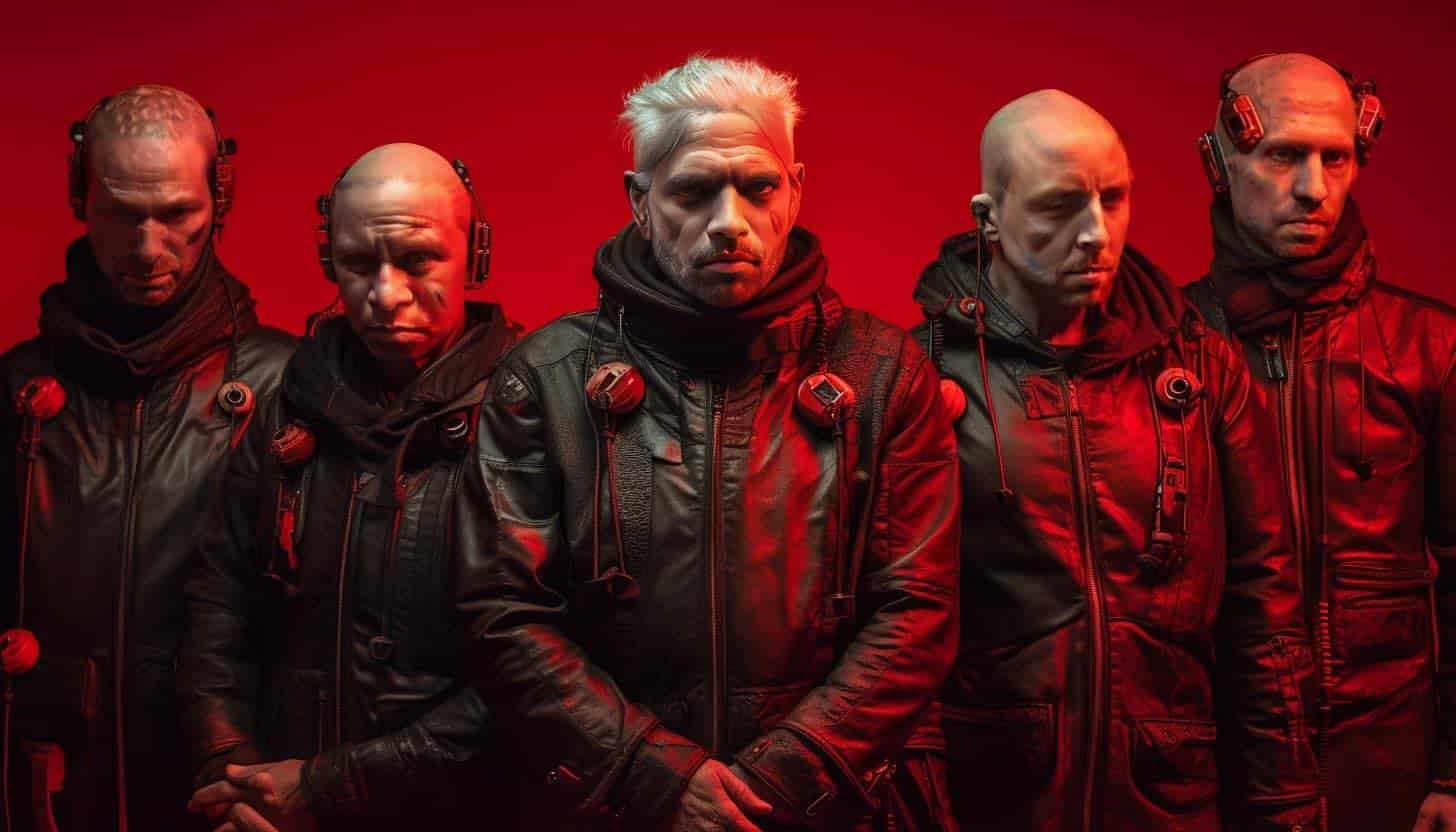
Did you see the images of us? It was so fascinating, man. It’s disturbing. It really is. It’s so disturbing. And I had to almost get all the guys to sign, ‘Is it okay for us to take your image and make new images of you?’ And we had to say that we can’t really ask you for each and every image. There’s going to be so many. And they’re like, ‘Yeah, sure.’ And some of them, they’re so accurate. It looks exactly like it’s one of us, but they were never there. They never had that makeup on or that costume, and they never had that look. It’s old news with the whole deep fake and all of that. But it’s scary, man. We didn’t do this just because we’re like, ‘Yippie, AI!’ It’s more like, ‘Oh my God, this AI shit is really, really interesting and scary, but also fascinating. Let’s see what …’ and one of the things we wanted to do was to use AI to just create the Datarock album and see how it works out. And if we think it’s funny, let’s just release it and then say, ‘This was AI-generated.’ But I guess that’s already been done a million times over the last couple of seconds, so perhaps we won’t.
